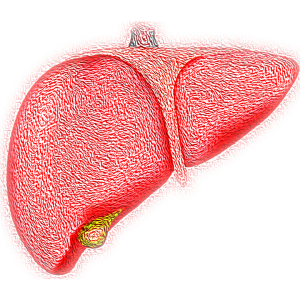 Non-alcoholic fatty liver disease (NAFLD), the build-up of fat in the liver that is not caused by alcohol, affects almost 100 million people in the United States alone. With no drug therapies available for the condition, treatment has focused mostly on weight loss. The more severe form of NAFLD, non-alcoholic steatohepatitis (NASH), causes the liver to swell and is associated with inflammation and liver scarring. There are typically few clinical symptoms of NASH until the disease is advanced, but it can lead to cirrhosis and carries risk of liver failure and death. NASH is a growing health concern whose incidence is rising along with increasing prevalence of type 2 diabetes and obesity. There are no approved drugs to treat NASH, although many companies are seeking to develop treatments for the disease, with ~50 NASH candidates in clinical trials, several of which are in Phase 3.
Non-alcoholic fatty liver disease (NAFLD), the build-up of fat in the liver that is not caused by alcohol, affects almost 100 million people in the United States alone. With no drug therapies available for the condition, treatment has focused mostly on weight loss. The more severe form of NAFLD, non-alcoholic steatohepatitis (NASH), causes the liver to swell and is associated with inflammation and liver scarring. There are typically few clinical symptoms of NASH until the disease is advanced, but it can lead to cirrhosis and carries risk of liver failure and death. NASH is a growing health concern whose incidence is rising along with increasing prevalence of type 2 diabetes and obesity. There are no approved drugs to treat NASH, although many companies are seeking to develop treatments for the disease, with ~50 NASH candidates in clinical trials, several of which are in Phase 3.
For example, Boehringer Ingelheim has made liver disease a major pipeline focus in recent years, adding several assets to its NASH portfolio through deals with Pharmaxis, Dicerna and MINA Therapeutics. In early July, the company licensed a first-in-class biologic for NASH and related liver diseases from South Korean company Yuhan Corporation. The deal gives Yuhan a $40 million upfront payment and up to $830 million in milestones for a biologic based on Yuhan’s long-acting Genexine fusion protein technology. The molecule combines dual agonist activity against GLP-1, a target of some type 2 diabetes drugs, and the liver hormone FGF21. The molecule is expected to work in multiple ways: by reducing fat accumulation in the liver, thus reducing liver cell injury and hepatic inflammation, and through direct anti-fibrotic effects. The deal is Yuhan’s first external partnership focused on biologics and the first out-licensing of a biologic targeting NASH from Korea. Boehringer Ingelheim and Yuhan have been long-time partners, with Yuhan marketing some of Boehringer’s cardiovascular and metabolic drugs in Korea.
Based on recent statements from the U.S. Food and Drug Administration (FDA), Boehringer and other companies developing NASH drugs may face challenges in demonstrating the efficacy of their therapeutics, especially if they aim to treat early stage NASH — fat accumulation and inflammation — rather than fibrosis. The agency recently issued draft guidance for the development of drugs to treat NASH patients with compensated cirrhosis, where liver scarring is present but patients experience limited symptoms and appear healthy. The FDA stated that there is “currently insufficient evidence to support the use of histological improvements as a surrogate endpoint.” Thus, the agency is proposing that it will only evaluate drugs for compensated NASH based on the traditional endpoints, which include time to disease complications as well as liver transplant or death, and will not grant accelerated approval based on histological endpoints.
The FDA has yet to approve any drugs to treat NASH, so the regulatory pathway remains somewhat undefined. However, the first approval may be coming soon. In February, Intercept Pharmaceuticals reported Phase 3 data from its REGENERATE study of Ocaliva (obeticholic acid) in NASH with liver fibrosis (Stage 2 or Stage 3 NASH). The results showed that 23% of patients treated with the high dose of Ocaliva experienced an improvement in fibrosis by one disease stage or more without worsening of NASH. Intercept is also conducting a Phase 3 REVERSE study in patients with compensated cirrhosis (Stage 4 NASH), where they hope to show improvements in liver scarring.
Given the often-silent nature of NAFLD and NASH, how will the FDA look at measures of efficacy for drugs that aim to treat earlier stages of liver disease, before damage is advanced and symptoms become more obvious? And given that the agency has yet to approve a drug for NASH, what will be the ultimate roadmap to approval for these therapeutics?